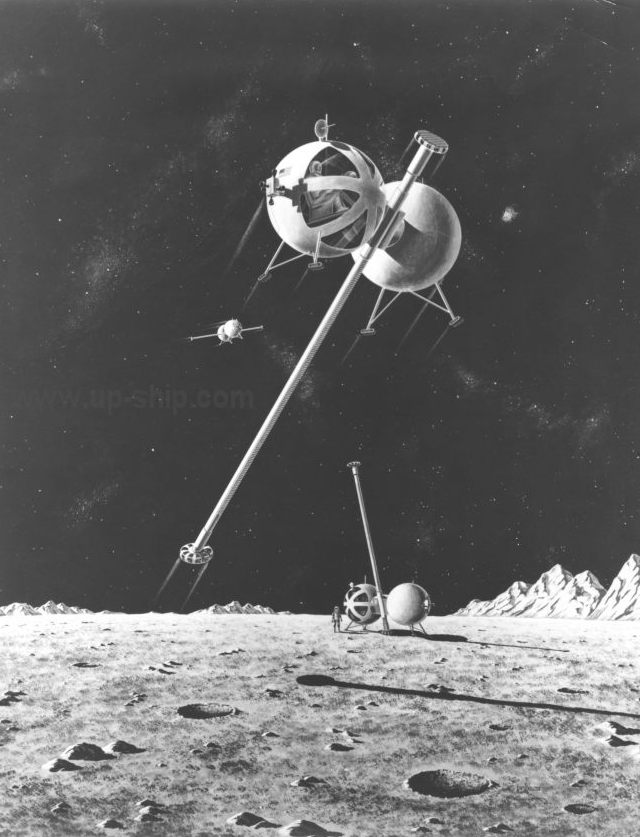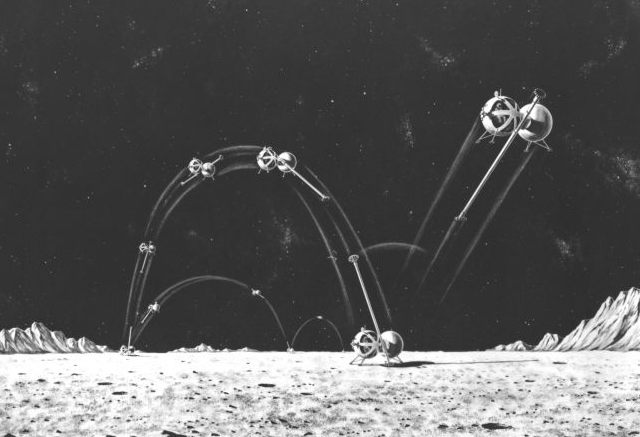
Taking 400-foot 15-second hops, lunar "pogo sticks" could most forward at about 20 miles an hour—much faster than the four to five miles an hour
of vehicles now being considered for moon exploration. The moon leaper was devised by Dr. Howard S. Seifert, scientist at the United Technology Center at Sunnyvale, Calif. This artist's concept shows lunar Ieapers in action, with the twin cabins in various positions for takeoff, flight and landing.
—AP Newsfeatures Photo.
Source: Reading Eagle 29 Jan 1967
Lunar Leaper Is Designed By Scientist
Sunnyvale, Calif. (AP)—The best vehicle for exploring the moon, once man was landed, may be a kind of pogo stick making 400-foot hops among the craters.
Dr. Howard S. Seifert, United Technology Center scientist subs also teaches at Stanford University, has worked out concepts for such a vehicle. He's serious.
Dr. Seifert has talked with others in the field and with various government agencies. including NASA. and says he has found a high degree of interest in the novel idea.
The monopod, moon hopper or lunar leaper—you name it—would consist of a 40-foot hollow pole between two cabins. The cabins—one carrying a pilot and a passenger, the other containing power plant, flight control equipment and a life support system — would ride up and down the pole on a cushion of compressed gas.
'Hop' Explained
As Seifert envisions it, a moon hop would start with the cabin structure resting rear the bottom of the pole. Pressure of gas against a piston would force the structure 30 feet up the pole, where it would lock in place, carrying the pole on upward with it on a ballistic trajectory.
The pole would be leaning forward at 45 degrees to the lunar surface at the start of the 400-foot, 15-second hop. Midway in flight, the lower end would swing forward in preparation for landing, when a big traction foot would contact the surface and the cabins would slide downward. compressing the gas again for the next leap.
The traction foot, the point of contact of the pole with the lunar surface, would be light, flexible. cleated and probably at least four feet across. It would be designed, Dr. Seifert said. to reduce bearing loads to acceptable values for the lunar soil.
Short Hops
The pole's momentum would swing it to position for the nest take-off during the one to two seconds between hops.
The craft would move forward at about 20 miles per hour, Seifert said.
This compares with a limit of four to five miles an hour for walking or wheeled vehicles now being considered for moon transport.
Seifert pointed to nature's hoppers—the kangaroo, rabbit, grasshopper and flea, among others.
"It would seem reasonable that matters and energy could be combined by man to create an efficient hopping transportation system on the moon," he said.
"Successful use of this system depends upon a lunar surface sufficiently free of large rocks and strong enough to support the vehicle."
Moon information accumulated thus far, mainly through photographs, indicates much of the terrain would be suitable for hopper travel, he said.
Paired gyroscopes would keep the cabins level and the pole correctly angled even if the foot skidded while landing on a sloping surface, Seifert said. Around the 200-foot-high apex of one jump, the pilot would select his landing point, using a computer and bomb-sight type device to pick a suitable bouncing spot.
Seifert said power would be supplied by a relatively small gas generator enabling the craft to move forward eight or nine miles on a gallon of standard fuel—"tremendously better than a rocket in that respect."
To Regain Energy
Once started. the hopper would regain about 80 per cent of its expanded energy in each gas compressing bounce-down, he explained. The bouncing mode of travel—with about 10 seconds of each hop bring spent above 100 feet—would aid observation and exploration, Seifert believes.
The scientist is a past president of the American Rocket Society and has served as vice president of the International Astronautical Federation and director of the American Institute of Aeronautics and Astronautics. He is the author of more than 30 papers on liquid, solid and nuclear rocket motor development and guided missile systems.
His moon hopper concept could be tested on earth, Seifert said, and colleagues at Stanford have expressed great interest in working out the system.
"Friends have said they'd like to test hop such a vehicle around a football field," Seifert said.

Artists Concert Illustration
Source: Popular Science, March 1969
Officially called "The Lunar Hopping Transporter", although attributed to Seifert, there were quite a few people involved in the research project for NASA for the Apollo Moon Mission program.
All is revealed in this 1971 Final Report to NASA.
Computer simulation of the Lunar Leaper.
The Demonstration model in 'flight'.
Seifert's concept for an Unmanned Hopper.
Note: The Hermann Oberth "Moon Car" of 1956 is incorrectly attributed to Seifert's Lunar Leaper.
First Presbyterian Church in Vallejo is inheriting the pipe organ from Luthern Church on Stanford Ave. in Palo Alto. On the side of the console there is a plaque saying " In Memory of Dr. Howard S. Seifert", so I went hunting to find out about Dr. Howard S. Seifert–sound like he was quite a guy!! Do you have a copy of his obituary that you could send us? (use my email)
A cool idea! I have a brief 8mm film of the earth-bound model that I inherited from Dr. Seifert when he died (he was my father). The fatal flaw in the idea was the comparative lack of control of the pilot once the pogo stick was launched and in the air. What if the pilot discovered he was heading for a deep crack in the moon's surface?